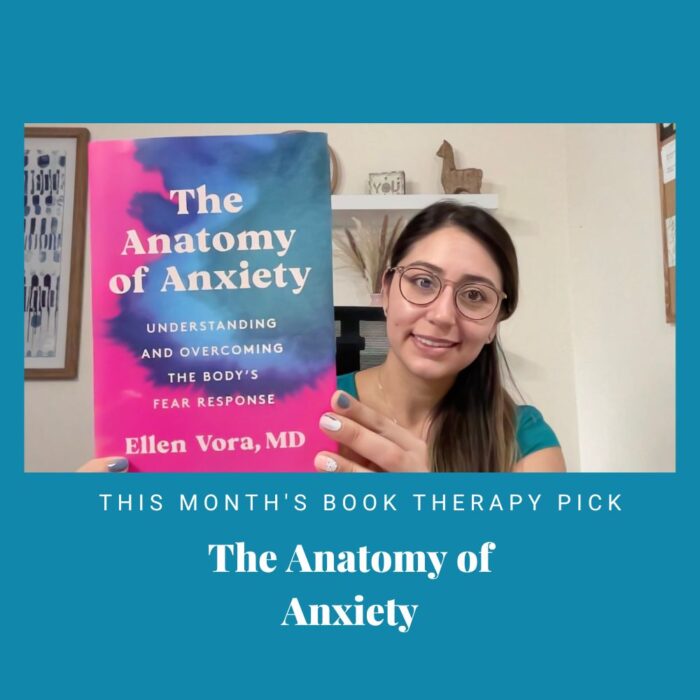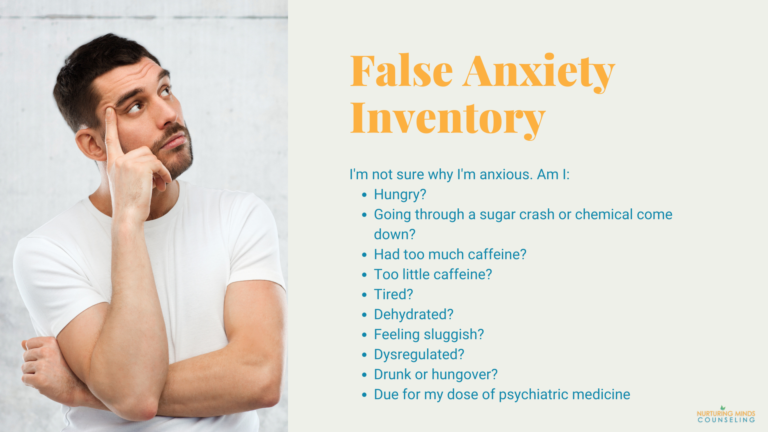Book Therapy: The Anatomy of Anxiety

If you’re looking for a book to help you with anxiety, then you cannot miss this month’s book therapy pick and must pick it up. This month’s pick is The Anatomy of Anxiety: Understanding and Overcoming the Body’s Fear Response by Dr. Ellen Vora.
My name is Diana Garcia and I’m a licensed mental health counselor in Florida and owner of a private practice called Nurturing Minds Counseling. If you’re new here, this is part of my monthly book therapy series where I pick one mental health self-help book to recommend, summarize, and pick out three key insights from the book.
Table of Contents
Watch the Video on Book Therapy: The Anatomy of Anxiety
Read Blog on Book Therapy: The Anatomy of Anxiety
You really are not going to want to miss this month’s therapy pick, which is “The Anatomy of Anxiety: Understanding and Overcoming the Body’s Fear Response” by Dr. Ellen Vora. She’s a psychiatrist and this is a relatively recent book. I saw this book a while ago, but I just haven’t had the time to read it. I finally picked it up and I’m so glad that I did! I’m going to get at least three insights from the book, but I could not do it justice in just three insights. So, if you struggle with any type of anxiety, I really recommend that you pick up this book.
Summary: The Anatomy of Anxiety
The book is broken down into three parts.
Part One is the first 3 chapters, and it explains anxiety, what anxiety is, and how it shows up.
Part Two is about False Anxiety, which is digging deep into all the factors that could impact your nervous system and make you have more False Anxiety. I will explain this more later. She also has a chapter on different factors and recommendations.
Part Three is about True Anxiety, so learning how to tune into it and factors that play a role in it manifesting.
Insight 1- Difference Between True Anxiety and False Anxiety
True Anxiety occurs when your body is conveying an important message about your life. It is crucial not to disregard these signals; instead, you should pay attention and understand what this type of anxiety is indicating. It can provide valuable insight into what is not right in your life.
False Anxiety, on the other hand, arises when your body sends a message that something is physiologically imbalanced. This imbalance could be due to lack of sleep, inadequate nutrition, or excessive caffeine intake. Dr. Vora also explains that stress responses due to an imbalance can manifest as anxiety symptoms. This means that anxiety isn’t solely a result of mental or emotional factors, but rather a combination of different physiological factors that contribute to this False Anxiety. What’s really helpful about this is that once you identify the cause or behaviors that are contributing, you might notice an improvement in your anxiety.
Dr. Vora aims to help you differentiate between different types of anxiety and reduce instances of False Anxiety by addressing changes in your life, which is the first part of the book. She provides advice on sleep, nutrition, gut health, and specific recommendations for females regarding their hormones and menstrual cycle. The book includes a False Anxiety inventory (see below) which I found helpful, especially for those dealing with anxiety. It guides you through a list to take a moment, pause, and evaluate yourself, potentially ruling out some common factors that many of us overlook, such as excessive caffeine, hunger, or a sugar crash.

Insight 2 – Cytokine Hypothesis
The cytokine hypothesis is a bit technical. Dr. Vora discusses the current perspective of mental health which is that mental health conditions develop due to certain deficiencies in specific neurotransmitters like serotonin and dopamine. Medications are often used to boost these neurotransmitters, particularly serotonin. While some practitioners still follow this model, there is some new research on the potential role of inflammation in the body and have it can negatively impact mental health.
Recent studies suggest that increased inflammation in the body leads to more negative outcomes, including impacts on mental health. It is believed that the body’s responses to inflammation mimic symptoms similar to anxiety and depression. These responses may signal that something is off physiologically. Supporting this theory is the fact that cytokines can cross the blood-brain barrier and directly impact parts of the brain associated with fear and threat, which are central to the anxious response.
Dr. Vora offers general recommendations, such as prioritizing anti-inflammatory foods and avoiding inflammatory foods. She also emphasizes the importance of focusing on gut health, as addressing gut issues can help with certain forms of anxiety. Furthermore, she stresses the importance of prioritizing rest, sleep, and relaxation, and learning how to manage stress better to close the stress cycle. Additionally, she highlights the role of vitamin D and suggests getting sunshine as a priority, as research indicates that getting vitamin D from the sun is more beneficial than through supplementation.
Insight 3 – Tune In True Anxiety
The third insight comes from the book’s third part, which focuses on working through True Anxiety. The book discusses how making changes in your life can help minimize False Anxiety, and then it delves into recognizing and addressing True Anxiety. Here are some general recommendations from part 3 to help with working through this:
1. Get curious: Instead of avoiding or suppressing your anxiety, start paying attention to it. If you feel uneasy about your relationship, job, or future, take some time to be still and practice mindfulness to listen to what your anxiety is trying to tell you.
2. Feel your feelings: The book emphasizes the importance of allowing yourself to feel all your emotions, not just the comfortable ones. By noticing any patterns in your feelings, you can gain insight into your upbringing, attachment, trauma, and more.
3. Practice gratitude: The book highlights the significance of gratitude in everyday life. It’s also important to learn to differentiate between a true yes and a true no. This involves somatically recognizing (tuning in with yourself) when something makes a request of you and making it a point to pause and listen to the wisdom that your body. Is this truly a yes? If not, then practice respectfully saying no.
The book also discusses the role of psychedelics, but I’m not an expert on the emerging field. If you’re interested in learning more about, the book provides some more information on it including, research, the author’s personal, and clinical experiences.
Next Steps:
- To see more book recommendations, check out my blog.
- If you could benefit from anxiety therapy, you’ll find more information on this page to help guide you.
- If you need extra resources and supportive coaching instead of therapy, feel free to explore my coaching business. I’m here to help!
As always, I hope you continue nurturing your mind, body, and soul, whatever that looks like for you!
This post contains affiliate links, and I may earn a commission if you make a purchase through these links at no extra cost to you. You are under no obligation to use these links.
